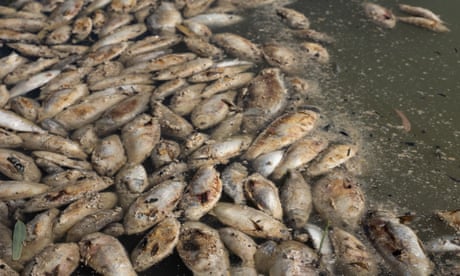- by foxnews
- 26 Nov 2024
EPA’s water testing after Menindee fish kill was flawed and insufficient, expert says
EPA’s water testing after Menindee fish kill was flawed and insufficient, expert says
- by theguardian
- 19 Apr 2023
- in news

Scientists have raised concerns about the accuracy of government water testing results from Menindee after a mass fish kill last month, with one saying if it were a first year university assignment, he would fail them.
The New South Wales Environment Protection Authority (EPA) this week released the long-awaited test results on six water samples taken from the Darling-Baaka River almost one month ago, on 21 March. The samples were collected five days after millions of fish were reported to be floating on the river's surface around the town of Menindee in far west NSW.
Dr Ian Wright, a professor of environmental science at Western Sydney University, said if the EPA's test results were an assignment submitted to him by one of his students, he would score it 3.5/10.
"If this was a first year assignment, I'd fail them," he said. "This is a complex and dynamic situation. We should have multiple days of data for something of this magnitude.
The NSW government has announced an inquiry into the fish deaths led by the state's chief scientist, Prof Hugh Durrant-Whyte. The terms of reference are being finalised.
Wright said he was "so thankful" there would be a "high quality" inquiry into the event, particularly in light of concerns around the testing.
He listed multiple concerns with the methodology behind the EPA's tests which he said would affect the accuracy of the results. They included:
The EPA published an overview on 6 April and released the full results after questions from Guardian Australia. The full results included tests for nutrients, algae toxins, metals and pesticides.
One of the samples, collected from the Darling River upstream of Menindee Creek, showed ammonia levels that were more than 50 times the Australian and New Zealand Guidelines for fresh and marine water quality. Wright said that in his opinion that amounts to "severe pollution". The EPA has not described it as a pollution event, saying test results showed the major fish kill was not caused by pesticides.
At the same sample site, the dissolved oxygen was 0.41mg/L. According to the EPA, dissolved oxygen lower than 1mg/L can be deadly for aquatic animals.
With those ammonia levels, in combination with the very low oxygen, Wright said he can't "imagine much surviving".
The EPA said it was working closely with a number of government agencies in response to the Menindee fish kill incident and has had multiple staff on the ground since 18 March.
"The EPA can investigate fish kills, often in conjunction with other NSW government agencies and local councils," the EPA said. "The EPA requested WaterNSW to collect samples while they were doing monitoring in the river. All samples were sent to an accredited laboratory."
Prof Fran Sheldon, a river ecologist who was on the independent panel which investigated the 2019 Menindee fish kills, said she doesn't think the NSW government agencies were "hiding anything or trying to cover up data" but that there should have been greater transparency.
"They probably should have just been testing daily and making it freely available," she said. "I'm not sure why they wouldn't have been testing through the whole thing once they realised it was happening."
In a statement, WaterNSW said it operates the Menindee lakes system under a strict regulatory framework and had worked with other agencies since October 2022, when "the likelihood of a flood-related blackwater event started to increase", to mitigate the worst impacts.
"WaterNSW anticipates that these operations will feature in the NSW government's inquiry into the circumstances surrounding the fish kill and will support that inquiry as the most appropriate forum to explore these matters," it said.
Sheldon said the challenge for WaterNSW will be to ensure that enough water flows through the system to flush the blackwater.
"They still have to let some water down to connect through those water holes that are chockas full of fish that will have declined water quality," she said. "Because if they don't, next summer we're going to see a 2019 event."
- by foxnews
- descember 09, 2016
The world's oldest Douglas fir trees have lived over 1,000 years
The Douglas fir, the state tree of Oregon, can grow incredibly tall and live impressively long. The oldest Douglas fir trees have lived to be over 1,000 years old.
read more


